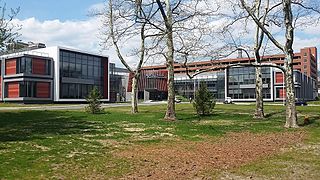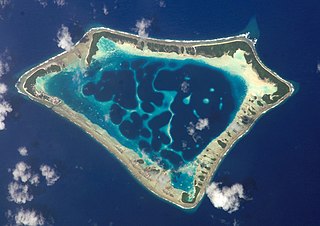
The Prince Charles Mountains are a major group of mountains in Mac. Robertson Land in Antarctica, including the Athos Range, the Porthos Range, and the Aramis Range. The highest peak is Mount Menzies. Other prominent peaks are Mount Izabelle and Mount Stinear. These mountains together with other scattered peaks form an arc about 260 miles long, extending from the vicinity of Mount Starlight in the north to Goodspeed Nunataks in the south.

Long Island Jewish Medical Center is a clinical and academic hospital within the Northwell Health system. It is a 583-bed, non-profit tertiary care teaching hospital serving the greater New York metropolitan area. The 48-acre (19 ha) campus is 15 miles (24 km) east of Manhattan, on the border of Queens and Nassau Counties, in Glen Oaks, Queens and Lake Success, New York, respectively. Its postal address is New Hyde Park on both sides of the city limits.

Abbotsmith Glacier is a well-defined glacier, 3 miles (5 km) long, descending from the ice-covered west slopes of Big Ben to the west side of Heard Island in the southern Indian Ocean. The glacier lies between Walsh and Henderson Bluffs. Surveyed in 1948 by the ANARE who named it for John Abbotsmith, engineer with the party.
Gilchrist Aiguilles is a series of sharp peaks close south of Mount Olsen on Laurens Peninsula, Heard Island.
Gilchrist Beach is a rocky beach, 1 nautical mile (1.9 km) long, lying west of Compton Glacier on the north side of Heard Island. At its eastern edge, Gilchrist Beach communicates with the sandy Fairchild Beach. Travelling eastwards from Gilchrist Beach to Fairchild Beach, one arrives at the base of Round Hill.
Lavett Bluff is a rock bluff between Deacock Glacier and Fiftyone Glacier on the south side of Heard Island in the southern Indian Ocean. It was surveyed in 1948 by an Australian National Antarctic Research Expedition (ANARE) and named "Cape Lavett" for Lieutenant John L. Lavett, Royal Australian Navy, one of the officers on HMAS Labuan, the relief ship for the expedition. Further ANARE exploration led to revision of the name in 1964 to Lavett Bluff.
Landing Bluff is a rock mass in Antarctica with a steep slope on the eastern side, with several small outcrops just to the south-west. It is located on the south-west part of Sandefjord Bay adjacent to Amery Ice Shelf, about 26 km west of Mount Caroline Mikkelsen. Mapped by Norwegian cartographers from air photographs taken by the Lars Christensen Expedition (1936–37) and called Strandknatten. A survey cairn was erected on the highest point by ANARE in 1968. So named because of its proximity to the landing place for stores and equipment for the ANARE Amery Ice Shelf party in January–March, 1968.
The Anare Nunataks are a group of mainly snow-covered ridges with exposed rock summits rising to 2,035 metres (6,680 ft), standing 16 nautical miles (30 km) south of the Stinear Nunataks in Mac. Robertson Land. First visited in November 1955 by an Australian National Antarctic Research Expeditions (ANARE) party led by John Béchervaise, the name is taken from the acronym of the expedition.
Budd Pass is a mountain pass in the ridge that extends southwest from Budd Peak on Heard Island. The pass is 1 nautical mile (2 km) southwest of Budd Peak. It was surveyed by Australian National Antarctic Research Expeditions (ANARE), 1948–63, and named by the Antarctic Names Committee of Australia for G.M. Budd, ANARE officer-in-charge on Heard Island in 1954 and leader of the 1963 ANARE Heard Island expedition.
Budd Peak is a peak, 2,315 metres (7,600 ft) high, 1.7 nautical miles (3.1 km) southeast of Mawson Peak on Heard Island. The peak was mapped by Australian National Antarctic Research Expeditions (ANARE) in 1948, and named by the Antarctic Names Committee of Australia for G.M. Budd, ANARE officer-in-charge on Heard Island in 1954, and leader of the 1963 ANARE Heard Island expedition.
Campbell Peak is a peak, 2,415 metres (7,920 ft) high, standing 1.2 nautical miles (2.2 km) northeast of Mawson Peak, the summit of Heard Island. It was surveyed in 1948 by the Australian National Antarctic Research Expeditions (ANARE), who named it for Group-Captain Stuart A. Campbell, Royal Australian Air Force. Campbell visited Heard Island in 1929 as aircraft pilot with the British Australian New Zealand Antarctic Research Expedition led by Douglas Mawson, and again as leader of ANARE when a research station was established on the island in December 1947.
Vrana Dome is a prominent, rounded ice dome about 4 nautical miles (7 km) northeast of Statler Hills, at the east side of Amery Ice Shelf A survey station was established on the dome during the ANARE tellurometer traverse from Larsemann Hills to Reinbolt Hills in 1968. Named for A. Vrana, cosmic ray physicist at Mawson Station in 1968, who assisted in the survey.
Walsh Bluff is a rock bluff close north of the mouth of Abbotsmith Glacier on the west side of Heard Island. Surveyed by ANARE in 1948. Named by Antarctic Names Committee of Australia (ANCA) for J.E. Walsh, ANARE weather observer on Heard Island in 1950 and 1954; dog attendant at Heard Island in 1951.
Stinear Nunataks is a group of dark brown nunataks about 16 nautical miles (30 km) north of Anare Nunataks in Mac. Robertson Land. Visited by an ANARE southern party (1954) led by R.G. Dovers. He named the group for B.H. Stinear, geologist at Mawson Station in 1954. Among the peaks is Zebra Peak, named for its distinctive alternating bands of light and dark rocks.
Trost Rocks is a two rock outcrops at the northeast end of Single Island on the west side of the Amery Ice Shelf. The rocks were photographed from ANARE aircraft in 1956 and their position fixed by a field party in December 1962. Named by Antarctic Names Committee of Australia (ANCA) for P.A. Trost, electronics engineer at Mawson Station in 1962, a member of the field party which visited the rocks.
Hamilton Bluff is a rock bluff on the coast of Antarctica, about 2 nautical miles (4 km) west of Palmer Point and 10 nautical miles (19 km) west of Mount Caroline Mikkelsen. It was first mapped by Norwegian cartographers from air photos taken by the Lars Christensen Expedition, 1936–37. It was visited by I.R. McLeod, geologist with the Australian National Antarctic Research Expeditions (ANARE) Prince Charles Mountains survey party, 1969, and was named by the Antarctic Names Committee of Australia for R. Hamilton, a helicopter pilot with ANARE in 1968.
Twilight Bay is a small re-entrant of the ice shelf into the plateau on the west side of the Amery Ice Shelf. Photographed from ANARE aircraft in 1956. The position of the feature was fixed by ANARE survey party in February 1968. So named because the survey party was flown into the area after sunset, necessitating navigation and photo identification in twilight.
Tingey Rocks are two small rock features located southwest of Single Island on the west edge of the Amery Ice Shelf. Discovered by the ANARE Prince Charles Mountains survey party in 1971. Named by Antarctic Names Committee of Australia (ANCA) for R.J. Tingey, geologist with the party.

Arriens Glacier is a small Antarctic glacier, south of Casey Point in the Mawson Escarpment, flowing west to reach Lambert Glacier. It was plotted from ANARE aerial photographs taken in 1956, 1960 and 1973, and named by the Australian Antarctic Names and Medals Committee after P. Arriens, geochronologist with the ANARE Prince Charles Mountains survey party in 1973.

Amanda Bay, also sometimes known as Hovde Cove, lies in southern Prydz Bay on the Ingrid Christensen Coast of Princess Elizabeth Land, East Antarctica. It is best known for its breeding colony of several thousand pairs of emperor penguins on sea ice at the south-west corner of the bay.





